Bulletin – March 2013 Australian Economy The Business Services Sector
- Download the article 1.66MB
Abstract
The business services sector has become increasingly important in the Australian economy. The strong growth in its output and employment has been largely driven by demand for the professional, scientific and technical inputs that firms in this sector provide to other businesses. This, in turn, has reflected increased demand for the output of highly skilled labour by the mining industry and other parts of the economy, the increased use of outsourcing, and a range of technological developments.
Introduction
The business services sector has grown strongly for an extended period and it now accounts for one-quarter of Australia's output and one-fifth of total employment. However, despite its size, developments in the business services sector tend to attract less attention than those in other parts of the economy. Using data from the Australian Bureau of Statistics as well as information gathered through the Bank's liaison with firms, this article discusses the composition of the business services sector and outlines the factors that lie behind its recent growth. The article focuses on structural changes that have affected the business services sector – notably, the expansion of the mining industry, shifting patterns of production and demand within the economy, and technological advances.
Recent Output and Employment Trends
Business services firms provide a range of assistance to other companies, such as technical and financial advice, leasing of equipment and temporary administrative support. The output of the business services sector is used by a wide range of other industries so they can undertake their day-to-day operations efficiently. As a consequence, trends within the business services sector are affected by the strength of demand and changing production processes within other industries. Technological changes across the economy also play a major role.
There is no straightforward definition of industries that comprise the business services sector. This reflects challenges in identifying businesses that provide services that are used in-house by other companies (such as consulting and information technology support) from those businesses that provide storage and distribution services for other companies' goods (such as wholesale and transport services, which are classified under the goods distribution sector).[1] It is also difficult to classify firms that in practice serve both the business and household sectors (such as telecommunications and financial services providers). And finally, it is hard to classify some firms that employ staff directly to undertake business services activities in-house but which are primarily focused on other activities such as goods production (like manufacturing companies that employ accounting staff). While acknowledging these difficulties, in this article we focus on developments in five industries that provide non-distribution services to other companies, namely:
- Professional, scientific & technical services: firms that provide highly skilled services to other companies such as engineering, architecture, legal, accounting, consulting, research, advertising and computer systems design.
- Administrative & support services: firms that help with building maintenance, labour hire operations, travel arrangements, packaging and outsourced office process services.
- Rental, hiring & real estate services: firms that lease equipment and transport vehicles, and firms that provide property management and real estate services.
- Information media & telecommunications: firms that manage telecommunications, internet and data management infrastructure, as well as those that create, manage, broadcast or provide information (including newspapers, magazines, books, television, radio, cinemas and music publishing).
- Financial & insurance services: firms that facilitate financial and insurance-related transactions and provide financial advice.[2]
Taking these five industries together, business services output has grown strongly, with growth averaging 5 per cent a year over the past 15 years and its share in nominal output increasing from 21 per cent in 1997 to 26 per cent by 2012 (Graph 1). Employment in these industries has also increased strongly, with growth averaging 3 per cent a year over the same period and its share in total employment rising from 17 per cent to 19 per cent. While growth of business services output slowed during the global financial crisis in 2008, trends in the business services sector have generally been less cyclical than in industries associated with goods production, such as mining, manufacturing and construction (Graph 2).[3]
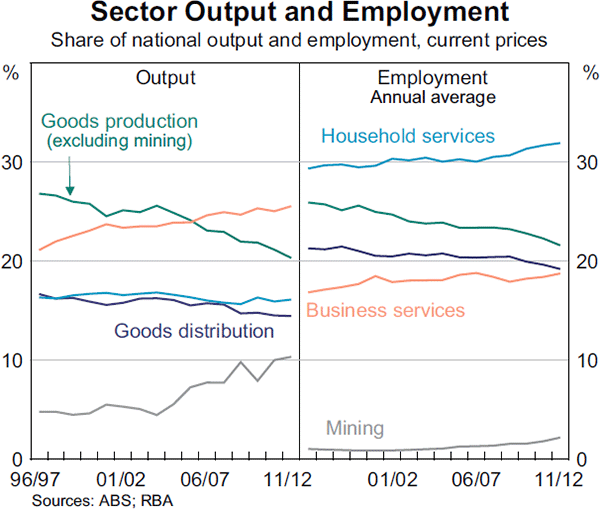
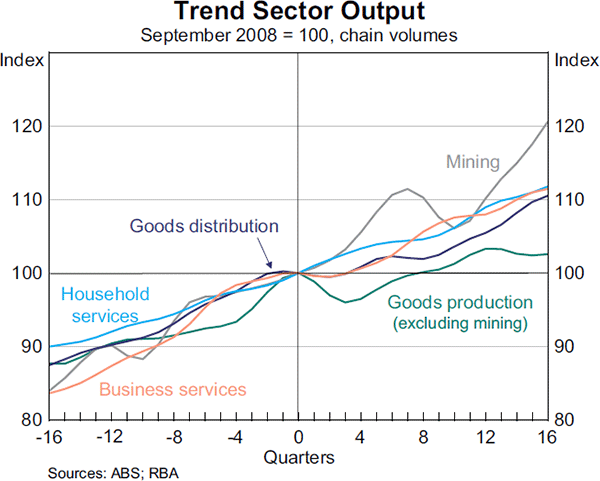
The large increases in the output and employment shares of the business services sector mask considerable variation within the sector. The rise in the output share of business services has primarily reflected growth in its two largest industries – the professional, scientific & technical services industry and the financial & insurance services industry – which together comprise around two-thirds of the sector (Graph 3). In contrast, the output shares of the administrative & support services and the rental, hiring & real estate industries have been relatively stable over time while that of the media & telecommunications industry has declined.
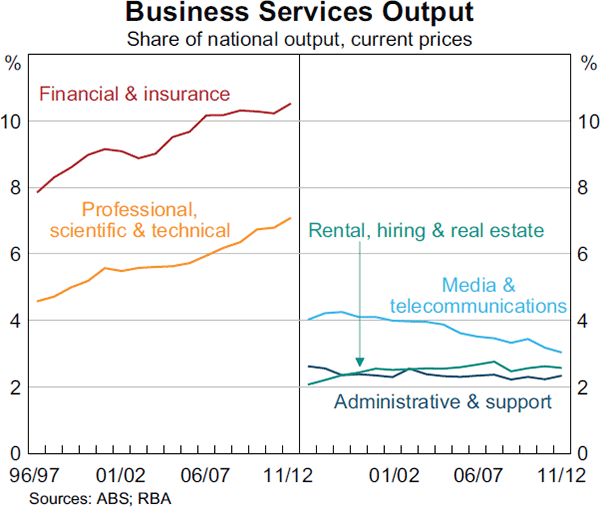
The rise in the business services employment share has been driven by growth in just the professional, scientific & technical services industry (Graph 4). The employment shares of the financial & insurance, administrative & support and rental, hiring & real estate services industries have remained little changed, while the media & telecommunications industry has seen a slight decline over an extended period.
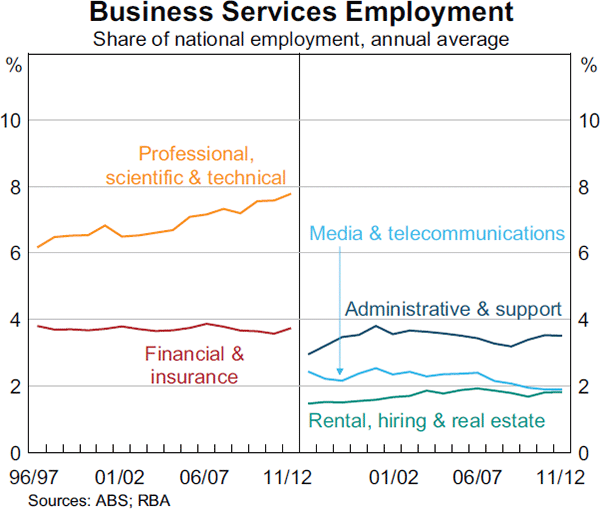
Factors Affecting the Growth of the Business Services Sector
The output and employment trends within the business services sector reflect four interrelated factors: the growth of the mining sector; the trend increase in the demand for the output of skilled labour within the economy; the increased use of outsourcing by firms to acquire business services inputs; and technological developments. The impact of these factors on specific industries within the business services sector has varied, and some of these factors have been important for an extended period while others have been more recent phenomena.
Growth of the mining sector
The rise in global commodity prices from the mid 2000s and the associated growth of mining investment and export activity have had a positive effect on many business services industries. Major beneficiaries have been employment services firms, engineering & technical services firms, and vehicle & equipment leasing providers (all of which are subsets of the five broad industries discussed above). Indeed, two-thirds or more of the firms in these areas that participate in the Bank's business liaison cite a substantial, or at least some, benefit from the growth of the mining industry over the year to mid 2012 (Graph 5). While the reappraisal of mining investment prospects towards the end of last year has weighed on demand for business services in the coal and iron ore industries – especially for exploration and construction-related services – demand for these types of business services from the liquefied natural gas (LNG) industry and for current mining production has continued to be strong.
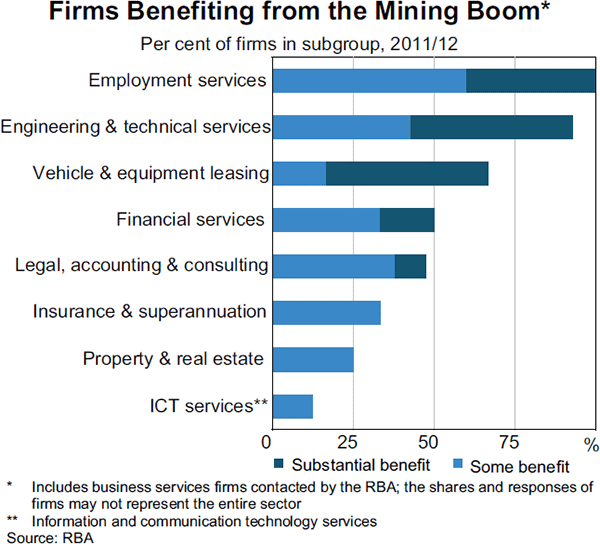
The boost to activity from the mining sector has reportedly been less substantial for other firms within the business services sector. Such firms generally have a wider client base in the non-mining sector and also tend to be smaller companies, which in general report fewer benefits from the expansion of the mining industry than larger companies (Graph 6). Nonetheless, some firms do report a substantial effect from the mining industry on their demand. Legal, accounting & consulting firms that have an exposure to mining-related firms have, until recently, generated strong revenue growth. Similarly, some property & real estate firms have benefited through their exposure to the commercial property market, especially in the states with substantial mining activity. The mining industry has also created demand for financial services such as capital raising and mergers & acquisitions services, partly offsetting weaker demand for these types of services from the non-mining sector.
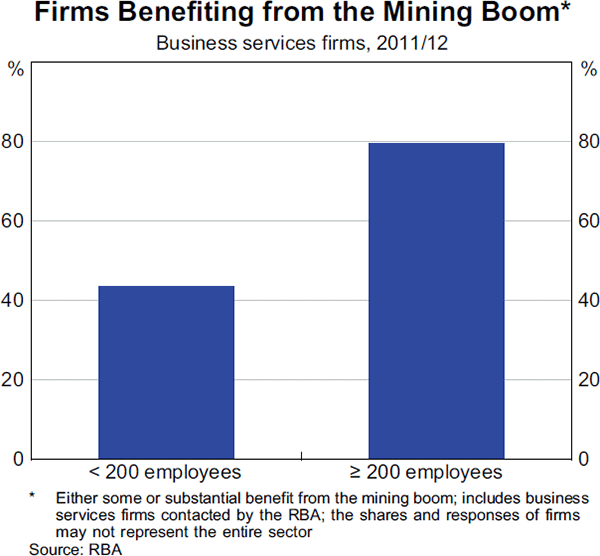
The strong growth in mining-related business services output has had an important regional dimension. The concentration of mining in Western Australia and Queensland and the labour-intensive nature of the business services sector has led some business services firms to relocate staff from New South Wales and Victoria to their offices in Brisbane and Perth, and some firms have opened or expanded offices in specific towns and cities with high levels of mining activity, such as Gladstone, Karratha and Port Hedland. As a consequence, professional, scientific & technical employment has increased significantly in the states with substantial mining activity relative to levels in the late 1990s/early 2000s, although there is tentative evidence that demand for this type of labour has flattened in Queensland of late (Graph 7).[4] Still, while recent data suggest that current labour shortages are lower than in the period prior to the onset of the global financial crisis, shortages in some specific skilled professions remain across the country – especially for engineering professionals (Graph 8). These shortages have until recently been a commonly reported constraint on the ability of business services firms to increase their exposure to the mining industry.
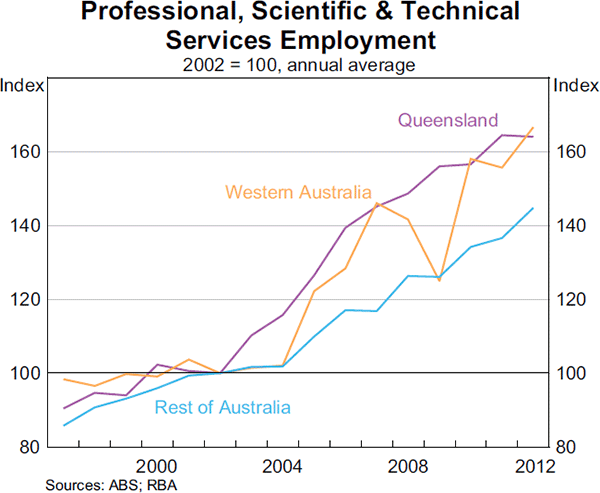
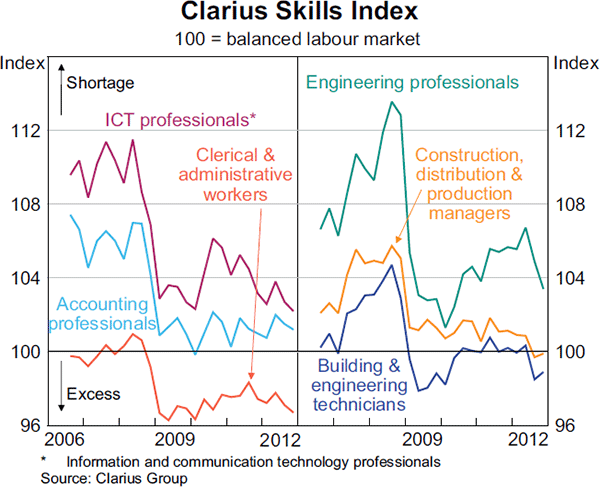
Overall, the expansion of the mining industry has provided a boost to activity in different parts of the business services sector. As the mining boom matures, the nature of the mining industry's demand for the output of the business services sector is likely to change. For example, engineering firms that currently provide services during the construction phase may not be as heavily in demand – nor have the suitable skills – to service mining production operations. And employment services firms may derive less benefit since the move from the investment to the production phase of the mining boom requires a more permanent and generally smaller workforce. In contrast, equipment leasing services are likely to remain in demand.
Rise in skilled labour demand and wages
While the mining sector has increased the demand for specialised skilled labour over recent years, more broadly, production in the Australian economy has become increasingly high-value and service-based over time. This has involved a shift in demand away from lower-value output for which Australia does not have a comparative advantage. As in many other developed economies, this partly reflects the strong growth in demand for services rather than goods output as real incomes increase. Because of the lower degree of tradability of services internationally, this demand has to be met through the production of more services locally. It also reflects longstanding technological developments that have tended to favour demand for highly skilled labour. The consequence of both of these trends has been an increase in the wages of highly skilled labour relative to those of less skilled labour.
Different industries within the business services sector employ varying shares of both skilled and less skilled labour. This has meant that, while average wages in the business services sector – as measured by the wage price index (WPI) – have grown at around the same pace as those in the rest of the economy, there has been considerable divergence in the average wage growth in different industries within the sector. In particular, in the professional, scientific & technical services industry – where close to 60 per cent of total employment is skilled labour – wages have grown much faster than those in other business services industries and in the overall economy (Graphs 9 and 10). The rise in demand for the output produced by the professional, scientific & technical services industry, combined with the associated strong growth in the wages of its professionals, is consistent with the large increase in its share in output over time.
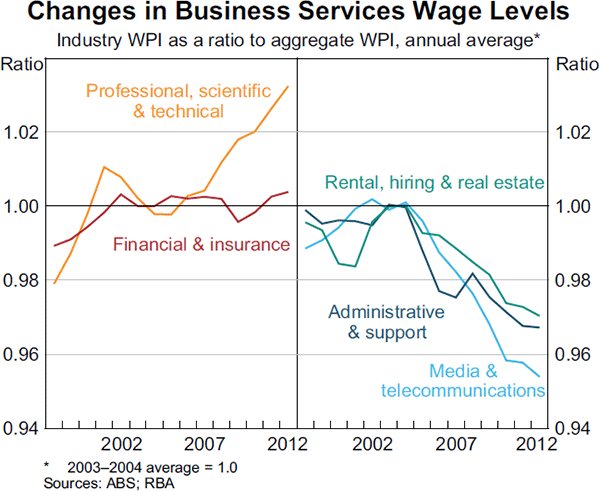
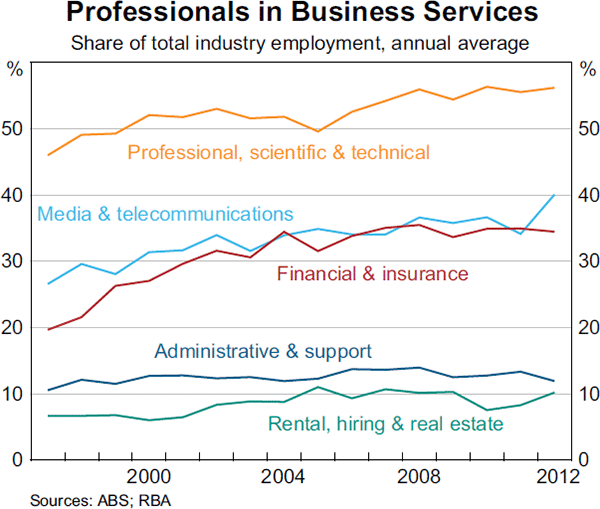
The share of professionals in the financial & insurance services industry has also increased over time, and presently stands at around one-third of its total employment. However, overall wages in the financial & insurance services industry have tended to grow at around the same rate as the economy as a whole. Structural changes associated with technological developments – including the introduction of automatic teller machines, internet banking and electronic payment methods – have seen a decline in demand for clerical staff within bank branches (Graph 11). This has been partially offset by employment of auxiliary financial advisory and brokerage services, as well as in the health & general insurance sub-sector.[5]
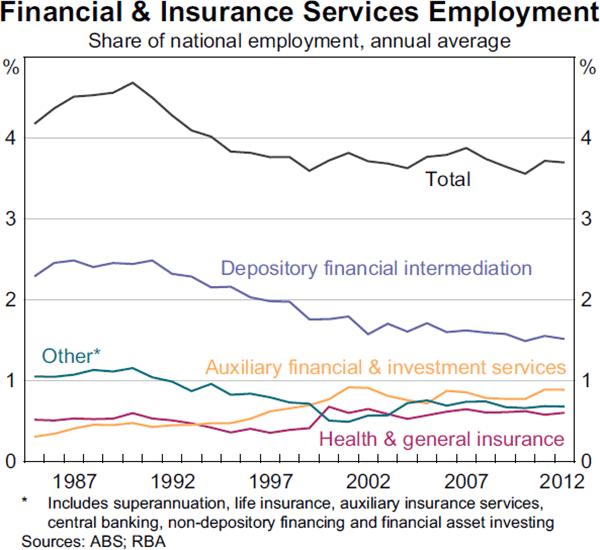
In contrast, the rental, hiring & real estate and the administrative & support services industries have a relatively high share of labourers, sales, clerical and administrative staff, and their average wages have grown more slowly than those of the economy overall. Finally, although the media & telecommunications industry employs around the same share of professionals as the financial & insurance services industry, Bank liaison suggests that strong competitive and cost pressures, combined with significant changes in digital technology (outlined below), have seen average wages and output in the media & telecommunications industry grow more slowly than in the economy overall.
Increase in outsourcing
For some time, activities that had been conducted in-house by many firms – such as accounting, computing and cleaning – have been increasingly contracted to business services companies that specialise in the provision of these types of activities. This has enabled firms to better focus on their core expertise and has provided them with an opportunity to lower the per-unit cost of ancillary services. This reallocation of employment across firms within the economy has tended to boost the output and employment of the specialised firms within the business services sector that provide these services, notably those providing professional, scientific & technical services and administrative & support services. At the same time, it has reduced employment in the firms that previously generated these services in-house (e.g. firms within the manufacturing sector).[6]
The drive for increased efficiency in the face of strong competitive pressures as well as advances in communication technologies have also underpinned efforts to shift parts of the internal operations of some business services firms offshore, especially for larger firms. For example, some engineering firms have moved parts of their design & drafting work overseas and some advertising firms have offshored parts of their digital production; more broadly, various business services firms have shifted back-office jobs offshore while keeping higher-skilled jobs in Australia. In addition, skill shortages in Australia have encouraged some firms to move operations offshore where certain engineering and information technology skills are more abundant. These activities have enabled business services firms to offer their activities to other Australian businesses at a lower cost than would otherwise be the case.
While the increase in global commodity prices since the mid 2000s has been associated with a large appreciation of the Australian dollar, Bank liaison with business services firms suggests that their efforts to move some parts of their internal operations offshore have mostly been motivated by the desire for longer-term cost reductions rather than in direct response to the higher exchange rate.[7] Compared with other service industries – such as tourism and education – the output of Australia's business services sector is not especially trade exposed, with most firms neither exporting nor facing a high degree of import competition (Graphs 12 and 13). However, some activities are more exposed than others and the tradability of some business services appears to be rising over time. Currently, the most trade exposed part of the business services sector is the professional, scientific & technical services industry. Looking at activities within that industry, exports and imports of legal, accounting & consulting services in particular have been rising over time. Imports of architectural, engineering & scientific services have also increased strongly since the mid 2000s, in line with the rise in demand from the mining industry.
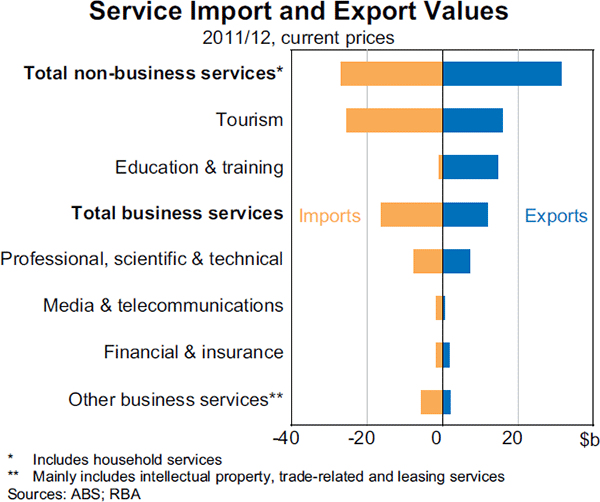
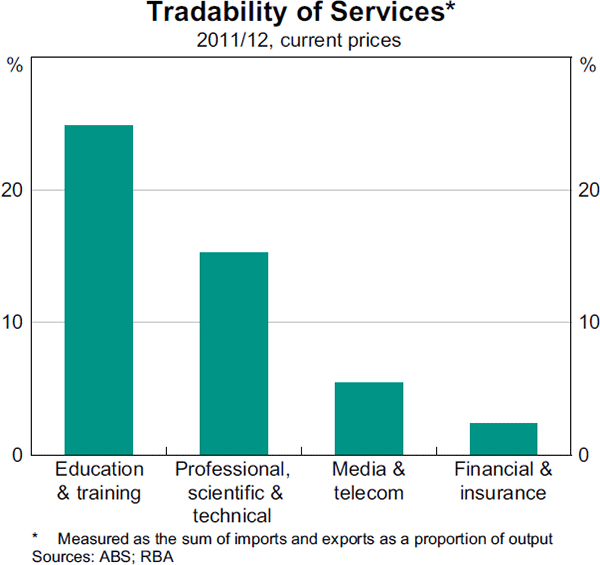
Advances in information technology
Advances in information technology are having a marked effect on the size and growth of different firms within the business services sector. In recent years, two key developments have helped facilitate rapid advancements in digital technology: information and internet connections have become faster and more reliable, and mobile internet has become increasingly widespread due to the rollout of 3G and 4G wireless internet networks and the popularity of smartphones and tablet computers. These technological advances have been both a challenge and an opportunity for businesses. On the one hand, the freer flow of information has intensified the competitive environment that many businesses face, particularly those in the retail sector. On the other hand, the technological advances are providing businesses with new means to change their internal processes in order to raise efficiency and remain competitive. For example, the growth of cloud computing services is enabling both small and large businesses to outsource some of their information systems requirements and thereby lower costs.
Accordingly, businesses are increasingly seeking professional consulting services to help make better use of new technology. Demand for consulting services is being generated from the uncertainty resulting from the rapid pace of technological advancement; since utilising new technology may entail a large scale of investment, companies seek advice from business service specialists on whether new products will be able to meet their information technology needs now and in the future.
Developments in digital technology are having a marked effect on print media and television broadcasting firms as households and businesses access information and entertainment media via the internet rather than through more traditional channels. Print media has seen a fall in advertising revenue and, in response, print media business services firms are investing in digital content delivery, such as the development of mobile device applications and paid content websites. Costs are also being lowered, including through reductions in the labour force and shrinking the size of newspapers. Television networks are also trying to increase their internet revenues by, for example, offering advertising on programs that can be streamed on demand from the internet.
In addition, the growth of digital media has increased the demand for some advertising services firms, since advertisements need to cover a wider range of media. As demand for digital advertising has grown, both media and advertising services firms have reported difficulty finding staff with online digital expertise, which is limiting the pace of expansion of these parts of the business services sector. As noted earlier, however, strong competitive and cost pressures within that industry have contained the pace of wages growth and the output share of the media & telecommunications sector has declined.
Conclusion
The business services sector has been one of the fastest growing sectors in the economy in terms of both its output and employment. The expansion of the mining industry and the increased outsourcing of auxiliary services to specialised firms have been important drivers of this growth, though its impact has varied across different firms within the sector. Technological developments and the general rise in the demand for skilled labour have led to the growth of some firms in the business services sector – especially in the professional, scientific & technical services industry – but also to a relative decline in some others. These trends are likely to see further increases in the output and employment shares of the relatively higher-skilled parts of the business services sector. At the same time, the shift from the investment to the production phase of the mining boom and the increasing ability to trade some services internationally are likely to see ongoing changes in the nature of the demand for domestically produced business services.
Appendix A
| ANZSIC 2006 Division (2011/12 share of output, employment) |
ANZSIC 2006 Group |
|---|---|
| Professional, scientific & technical services ( 7 per cent, 8 per cent) |
Computer system design and related services |
| Scientific research services | |
| Architectural, engineering and technical services | |
| Legal and accounting services | |
| Advertising services | |
| Market research and statistical services | |
| Management and related consulting services | |
| Veterinary services | |
| Other professional, scientific and technical services | |
| Administrative & support services (3 per cent, 4 per cent) |
Building cleaning, pest control and gardening services |
| Packaging services | |
| Employment services | |
| Travel agency and tour arrangement services | |
| Other administrative services | |
| Rental, hiring & real estate services (2 per cent, 2 per cent) |
Property operators |
| Real estate services | |
| Motor vehicle and transport equipment rental and hiring | |
| Other goods and equipment rental and hiring | |
| Farm animal and bloodstock leading | |
| Non-financial intangible assets (except copyrights) leading | |
| Information media & telecommunications ( 3 per cent, 2 per cent) |
Telecommunications services |
| Internet service providers and web search portals | |
| Data processing, web hosting and electronic information storage services | |
| Newspaper, periodical, book and directory publishing | |
| Software publishing | |
| Motion picture and video activities | |
| Sound recording and music publishing | |
| Radio broadcasting | |
| Television broadcasting | |
| Internet publishing and broadcasting | |
| Libraries and archives | |
| Other information services | |
| Financial & insurance services (11 per cent, 4 per cent) |
Depository financial intermediation |
| Non-depository financing | |
| Financial asset investing | |
| Superannuation funds | |
| Auxiliary finance and investment services | |
| Health and general insurance | |
| Life insurance | |
| Auxiliary insurance services | |
| Central banking | |
|
Source: ABS |
|
Footnotes
The authors are from Economic Analysis Department. [*]
Apart from the business services sector, the other main sectors are: goods production (agriculture, mining, manufacturing, utilities and construction, which together account for around 30 per cent of output); goods distribution (retail, wholesale and transport, around 15 per cent of output); and household services (accommodation & food, education, health, arts and other services, also around 15 per cent of output). Ownership of dwellings and public administration & safety make up the balance of the output shares. [1]
See Appendix A for a more detailed description of the type of activities reflected in these groups. [2]
Nonetheless, some parts of the business services sector fared better than others; administrative & support services output fell sharply during the downturn and employment in that industry declined, financial & insurance services output flattened noticeably after a period of very strong growth, but the rapid growth of professional, scientific & technical services output was largely unaffected. [3]
However, the mining industry still employs a relatively low share of all the professional services workers employed in Australia. The number of professional services workers in the rest of Australia has continued to grow strongly as well. [4]
These trends have primarily been led by households rather than businesses, in response to rising demand for wealth management services and changes in government health policies in 1999–2000. The rise in the share of the financial & insurance services industry in total output has in part reflected strong profit growth in that industry as well. [5]
For more details, see Productivity Commission (2012), Annual Report 2011–12, Annual Report Series, Productivity Commission, Canberra. Available at <http://www.pc.gov.au/__data/assets/pdf_file/0018/120258/annual-report-2011-12.pdf>. [6]
Nonetheless, the appreciation of the currency has reduced import costs for the business services sector, which has benefited firms such as those providing engineering services. [7]